Selection of Energy Improvement Factors and Economic Analysis of Standard MDU Complexes in Korean Metropolitan Regions
Abstract
:1. Introduction
2. Methods
3. Selection of Standard MDU Using ECO2
3.1. Definition of ECO2
3.2. Standard MDU
3.2.1. Floor Area
3.2.2. Insulation Performance and Facility Status
3.2.3. Annual Energy Demand, Energy Consumption and Primary Energy Consumption
3.2.4. Selection of Standard MDU Complex
4. Selection of Improvement Factors
4.1. Energy-Saving Factors Applied to the Latest MDU Complexes
4.1.1. Insulation Performance and Facility System Status
4.1.2. Energy Demand, Energy Consumption and Primary Energy Consumption Analysis
4.2. Analysis of Improvement Effect
4.2.1. Effect of Exterior Wall Insulation Improvement
4.2.2. Effect of Window Improvement
4.2.3. Effect of Ventilation System
4.2.4. Effect of New and Renewable System
4.3. Selection and Verification of Optimal Improvement Factors
4.3.1. Improvement Effect by Applying the Optimal Improvement Factor
4.3.2. Examples of Calibration through Verification
5. Economic Analysis
5.1. Annual Energy Usage Fee Analysis
5.2. Life Cycle Cost Analysis
6. Discussion
7. Conclusions
- (1)
- As a result of analyzing 46 MDU complexes that obtained building energy efficiency rating certification from 2014 to 2015, the average energy demand per unit area per year was found to be 107.5 kWh/m2, the average energy consumption per unit area per year was 146.5 kWh/m2, the average primary energy consumption per unit area per year was 150.7 kWh/m2. The building energy efficiency rating was analyzed to correspond to an average of Grade 2.
- (2)
- The monthly heating energy requirement per unit area was analyzed, revealing that the monthly average heating energy demand of new energy saving MDUs in 2021 was reduced by 1.7 kWh/m2y compared to MDUs certified in 2014–2015.
- (3)
- As a result of analyzing the primary energy consumption reduction rate due to the simultaneous improvement of windows and ventilation systems, the building energy efficiency ratings of E and M complexes were improved by one grade. The reduction rate of primary energy consumption was analyzed as 26.8% for E complex and 32.5% for M complex.
- (4)
- As a result of life cycle cost analysis using the present value method for 30 years, it was confirmed that a profit of $1384.6~$1970.5 was acquired for M complex, which had undergone simultaneous improvement of the windows and ventilation system.
Author Contributions
Funding
Institutional Review Board Statement
Informed Consent Statement
Conflicts of Interest
References
- Park, Y.-G. Energy Policy Trends and Implications of Major Countries in the World; Korea Rural Economic Institute: Naju, Korea, 2015. [Google Scholar]
- Ministry of Environment. New Climate System after Kyoto Protocol Guide to the Paris Agreement; Ministry of Environment: Sejong City, Korea, 2016.
- 2050 Carbon Neutral Committee. 2030 National Greenhouse Gas Reduction Goal (NDC) Amendment. Available online: https://www.2050cnc.go.kr/base/board/read?boardManagementNo=4&boardNo=100&searchCategory=&page=1&searchType=&searchWord=&menuLevel=2&menuNo=15 (accessed on 18 October 2021).
- Kwon, P.-S.; Kim, S.-J. Scenario Analysis for the Achievement of the 2030 National Greenhouse Gas Reduction Goal in the Korean Electricity Sector. Korea Environ. Policy Adm. Soc. 2017, 25, 129–163. [Google Scholar]
- MOLIT, the 2nd Green Building Master Plan in Korea; Ministry of Land, Infrastructure and Transport: Sejong City, Korea, 2019.
- Airaksinen, M.; Matilainen, P. A carbon footprint of an office building. Energies 2011, 4, 1197–1210. [Google Scholar] [CrossRef]
- Acquaye, A.A.; Duffy, A.P.; Basu, B. Stochastic hybrid embodied CO2-eq analysis: An application to the Irish apartment building sector. Energy Build. 2011, 43, 1295–1303. [Google Scholar] [CrossRef] [Green Version]
- Birgisdottir, H.; Moncaster, A.; Wiberg, A.H.; Chae, C.; Yokoyama, K.; Balouktsi, M.; Malmqvist, T. IEA EBC annex 57 ‘evaluation of embodied energy and CO2eq for building construction’. Energy Build. 2017, 154, 72–80. [Google Scholar] [CrossRef] [Green Version]
- Zhang, Y.; Wang, J.; Hu, F.; Wang, Y. Comparison of evaluation standards for green building in China, Britain, United States. Renew. Sustain. Energy Rev. 2017, 68, 262–271. [Google Scholar] [CrossRef]
- Jeong, K.-B. Policies and Research Trends related to Green Remodeling. J. Korea Inst. Constr. Eng. Manag. 2021, 22, 32–35. [Google Scholar]
- Choi, M.-J.; Jeon, J.-W.; Lee, D.-H. The Analysis of Energy Performance for Certification Case of Zero Energy Building through Green Remodeling in Korea. J. Korean Inst. Arch. Sustain. Environ. Build. Sys. 2021, 15, 213–223. [Google Scholar]
- Lee, H.-J.; Kim, I.-S. A Study on the Issues and Trends of Zero Energy Policy. J. Energy Eng. 2020, 29, 79–84. [Google Scholar]
- Zero Energy Building. Available online: https://zeb.energy.or.kr/BC/BC03/BC03_06_001.do (accessed on 18 February 2022).
- Korea Heating, Air-Conditioning, Refrigeration & Renewable Energy News. Available online: http://www.kharn.kr/mobile/article.html?no=17680 (accessed on 31 October 2021).
- Building Life History Management System, Building Statistics. Available online: https://blcm.go.kr/stat/customizedStatic/CustomizedStaticSttst.do (accessed on 30 November 2021).
- Ministry of Land, Infrastructure and Transport, Existing Building Status. Available online: https://www.molit.go.kr/USR/NEWS/m_71/dtl.jsp?lcmspage=1&id=95085286 (accessed on 30 November 2021).
- Yoo, J.-H.; Lee, J.-G.; Kim, B.-J.; Bang, S.-K. A Study on the Improvement of Interest Support Program for Activating Green Remodeling Business. J. Archit. Inst. Korea Struct. Constr. 2019, 35, 147–152. [Google Scholar]
- Kim, S.-R.; Ahn, Y.-H. Identifying Drivers Influencing Green Remodeling Project in the Perspective of Participant. Archit. Inst. Korea Acad. Conf. 2018, 38, 696–699. [Google Scholar]
- Lee, Y.-Y.; Koo, B.-K.; Lee, K.-H. A Study on Policy Alternatives for Activating Green Remodeling of the Existing Building. J. Korean Inst. Arch. Sustain. Environ. Build. Sys. 2015, 9, 151–156. [Google Scholar]
- Nam, S.-H.; Kim, K.-R. The Study on the Project Delivery System for Vitalizing the Green Remodeling. J. Korea Inst. Constr. Eng. Manag. 2017, 18, 3–11. [Google Scholar]
- Ministry of Land, Infrastructure and Transport. Available online: http://www.molit.go.kr/USR/NEWS/m_71/dtl.jsp?lcmspage=7&id=95085598 (accessed on 30 November 2021).
- Main Purpose Building Energy Consumption Statistics. Available online: https://www.greentogether.go.kr/sta/sta010101.do (accessed on 30 November 2021).
- Building Energy Efficiency Rating System. Available online: https://beec.energy.or.kr/BC/BC04/BC04_04_001.do (accessed on 30 November 2021).
- Kim, T.-Y.; Kim, Y.-H.; Hwang, J.-H. Comparison of Primary Energy Requirement of Neighborhood Facilities according to Heat Source Types and Window Wall Ratio by Usage Purpose. J. Korean Inst. Arch. Sustain. Environ. Build. Sys. 2017, 11, 425–439. [Google Scholar]
- Korea Energy Agency. Building Energy Evaluation Program. Available online: https://www.energy.or.kr/web/kem_home_new/info/data/open/kem_view.asp?q=22116 (accessed on 30 November 2021).
- Ministry of Land, Infrastructure and Transport, Regulations on Building Energy Efficiency Rating Certification and Zero Energy Building Certification, Ministry of Land, Infrastructure and Transport Ordinance No. 878.
- Jeon, S.-M.; Choi, G.-S.; Kang, J.-S. A Method for the Classification of Calculation Method for Energy Consumption of School Buildings on ECO2 Software. In Proceedings of the 2019 SAREK Summer Annual Conference, Yongpyong, Korea, 25–28 June 2019; pp. 509–512. [Google Scholar]
- Park, S.-M.; Song, D.-S. Validation of Building Heat capacity on Building Energy Rating Evaluation Program in Korea. In Proceedings of the 2020 SAREK Summer Annual Conference, Pyeongchang, Korea, 21–23 June 2020; pp. 37–40. [Google Scholar]
- Kim, Y.; Yu, K.H. Study on the certification policy of zero-energy buildings in Korea. Sustainability 2020, 12, 5172. [Google Scholar] [CrossRef]
- Choi, B.E.; Shin, J.H.; Lee, J.H.; Kim, S.S.; Cho, Y.H. Establishment of passive energy conservation measure and economic evaluation of fenestration system in nonresidential building of Korea. Int. J. Polym. Sci. 2017, 2017. [Google Scholar] [CrossRef]
- Jradi, M. Dynamic Energy Modelling as an Alternative Approach for Reducing Performance Gaps in Retrofitted Schools in Denmark. Appl. Sci. 2020, 10, 7862. [Google Scholar] [CrossRef]
- No, S.T.; Kim, J.Y. A Comparison of Detailed and Simple Building Energy Analysis Tools for Eco–Friendly Office Building Design. In Applied Mechanics and Materials; Trans Tech Publications Ltd.: Freienbach, Switzerland, 2012; Volume 178, pp. 3–6. [Google Scholar]
- Kwon, J.H.; Jang, H.I.; Kim, M.K.; Park, H.S.; Suh, S.J. Comparison on the Annual Energy Demand by Building Energy Assessment Tool and Dynamic Energy Simulation. In Proceedings of the 2012 SAREK Summer Annual Conference, Yongpyong, Korea, 27–29 June 2012; pp. 363–366. [Google Scholar]
- Kim, M.-K.; Park, H.-S.; Song, K.-D. Evaluation and Analysis of Building Energy Rating System According to Insulation Performance of Building Envelope in Regional and Building Form of Apartment House. J. Korean SAREK 2013, 25, 49–54. [Google Scholar]
- Lee, D.-H.; Yoon, J.-H.; Lee, K.-W.; Seo, M.-G. Heating Energy Performance of Heated Glass According to Insulation Level of the Residential Building. J. Korean Sol. Energy Soc. 2021, 41, 73–84. [Google Scholar] [CrossRef]
- Kim, S.-B.; Lee, S.-Y.; Kim, S.-H.; Park, K.-Y.; Choi, W.-K. Correlation between Insulation and Energy of Windows in Apartment. In Proceedings of the 2017 SAREK Summer Annual Conference, Yongpyong, Korea, 26–28 June 2017; pp. 615–618. [Google Scholar]
- Passive House Institute Korea. Available online: http://www.phiko.kr/bbs/board.php?bo_table=z3_01&wr_id=5 (accessed on 30 December 2021).
- Ministry of Land, Infrastructure and Transport. Ministry of Land, Infrastructure and Transport Notice No. 878, Attachment 1. Available online: https://www.law.go.kr/admRulLsInfoP.do?chrClsCd=010202&admRulSeq=2100000073970#AJAX (accessed on 24 May 2022).
- Ministry of Land, Infrastructure and Transport. Ministry of Land, Infrastructure and Transport Notice No. 878, Attachment 2. Available online: https://www.law.go.kr/admRulLsInfoP.do?chrClsCd=010202&admRulSeq=2100000073970#AJAX (accessed on 24 May 2022).
- Kim, H.-S.; Yun, H.-D.; Byun, W.-S. A Study on the Evaluation of Apartment Building Energy Efficiency Rating Considering the Performance of Thermal Insulators and Window glasses. In Proceedings of the 2009 SAREK Summer Annual Conference, Yongpyong, Korea, 26–28 June 2009; pp. 706–711. [Google Scholar]
- Hyun, J.-H.; Hong, S.-H.; Park, H.-S.; Choi, M.-H. Study on High Performance Building Envelope for raising Building Energy Rating. In Proceedings of the 2008 SAREK Summer Annual Conference, Yongpyong, Korea, 26–28 June 2008; pp. 801–806. [Google Scholar]
- Cha, S.-G. Energy Saving Technology of Building Envelope; Korea Institute of Science and Technology Information: Daejeon, Korea, 2011. [Google Scholar]
- Jo, H.-P.; Oh, J.-H.; Kim, S.-S. A Study on the Target Parts for Envelope Remodeling Prototype to Improve Thermal Performance of Old Multi-family Residential Buildings. J. Korean Inst. Archit. Sustain. Environ. Build. Syst. 2017, 2, 52–57. [Google Scholar]
- Kim, C.-B.; Park, J.-U.; Kim, K.-S.; Lee, E.-J. Optimum Window Selection through Building Energy Performance Simulation. In Proceedings of the 1998 SAREK Summer Annual Conference, Yongpyong, Korea, 26–27 June 1998; pp. 1241–1246. [Google Scholar]
- Park, M.-S.; Kang, I.-K.; Lee, D.-W.; Cho, Y.-J.; Liu, J.; Lee, J.-H. U-value Characteristics of Window in Residential Building with the Variation of Specification. In Proceedings of the 1997 SAREK Summer Annual Conference, Yongpyong, Korea, 20–21 June 1997; pp. 132–138. [Google Scholar]
- Lee, J.-S.; Cho, S.; Jang, M.-S.; Jang, C.-Y.; Yoo, S.-W. Research about Thermal Performances of Windows and Doors System by Glass Association. In Proceedings of the 2002 SAREK Summer Annual Conference, Pyeongchang, Korea, 21–23 June 1998; pp. 1241–1246. [Google Scholar]
- Lee, K.-R.; Lee, Y.-S.; Lim, J.-H. An Analysis of the Shadow Influence of Roof-top Structure on Output Power of Photovoltaic System Mounted on Apartment Buildings. In Proceedings of the 2018 Architectural Institute of Korea Autumn Annual Conference, Pyeongchang, Korea, 23–26 October 2018; pp. 258–261. [Google Scholar]
- Lee, K.-R.; Lee, Y.-S.; Lim, J.-H. Evaluation on the Photovoltaic Module Arrangement Planning Considering Shading Conditions in Apartment Buildings. J. Arch. Inst. Korea Struct. Constr. 2019, 5, 169–179. [Google Scholar]
- Won, J.-H.; Tae, Y.-R. A Study on the Capacity Estimation of Photovoltaic System Applied to Multi-Unit Dwelling by Zero Energy Building Certification Grade. J. Korean Inst. Archit. Sustain. Environ. Build. Syst. 2021, 6, 279–288. [Google Scholar]
- Ministry of Land, Infrastructure and Transport. Energy Performance Improvement Standards of Existing Buildings. Ministry of Land, Infrastructure and Transport Notice No. 2021-322.
- Jeong, H.-S.; Byeon, I.-H.; Kim, W.-Y. A Improvement of Energy Efficient Ratings for Public Buildings. In Proceedings of the KIEE Conference; The Korean Institute of Electrical Engineers: Seoul, Korea, 2011; Volume 7, pp. 2097–2098. [Google Scholar]
- Korea Institute of Construction Technology. A Study for Standardization of Quantitative Evaluation Methods for Building Energy Performance; Ministry of Transportation: Sejong City, Korea, 2014.
- Jung, S.-H. A Study to Improve the Evaluating Tool for Based on Comparison between Actual Energy Use and Tool Result; Seoul National University of Science and Technology: Seoul, Korea, 2016. [Google Scholar]
- Jeon, B.-K.; Park, C.-Y.; Jang, H.-I.; Choi, S.-W.; Kang, M.-G.; Kim, E.-J. Comparison of ECO2 Results using Calibrated Input Data Pertaining to Room Operating Conditions. J. Korean Inst. Archit. Sustain. Environ. Build. Syst. 2018, 12, 223–234. [Google Scholar]
- Lee, A.-R.; Kim, J.-G.; Kim, J.-H.; Jeong, H.-G.; Jang, C.-Y.; Song, K.-D. Comparing the actual heating energy with calculated energy by the amended standard building energy rating system for apartment buildings. J. Korea Inst. Ecol. Archit. Environ. 2015, 15, 103–107. [Google Scholar]
- Kim, G.-T.; Chun, C.-Y.; Kim, S.-D. A Comparative Analysis of Energy Performance according to the Ventilation System in Apartment House. J. LHI 2015, 6, 215–220. [Google Scholar]
- Jung, S.-S. A Study on the Cost Breakdown Structure for Life Cycle Cost of Individual Air Conditioning system and Central Air Conditioning system. J. Archit. Insitute Korea Plan. Des. 2004, 20, 277–284. [Google Scholar]
- Jung, S.-S. A Study on the Development of Life Cycle Cost Analysis Methodology in HVAC system for Decision Maker. J. Korean Sol. Energy Soc. 2004, 12, 55–63. [Google Scholar]
- Kim, Y.-D.; Cha, H.-S.; Kim, K.-R.; Shin, D.-W. Evaluation Method of Green Construction Technologies Using Integrated LCC and LCA Analysis. J. Korea Inst. Constr. Eng. Manag. 2011, 12, 91–100. [Google Scholar]
- Korea Energy Statistical Information System, Energy Conversion Factor. Available online: http://www.kesis.net/sub/sub_EnergyChange.jsp (accessed on 30 December 2021).
- Korea District Heating Corporation. District Heating and Heating Fee Table. Available online: https://www.kdhc.co.kr/cyb/Cy_Content/CM2017.do (accessed on 30 December 2021).
- Korea Electric Power Corporation. Electricity Usage Rates for Houses. Available online: https://cyber.kepco.co.kr/ckepco/front/jsp/CY/E/E/CYEEHP00101.jsp (accessed on 30 December 2021).
- National Indicator System, Consumer Price Inflation. Available online: https://www.index.go.kr/unify/idx-info.do?idxCd=4226 (accessed on 30 December 2021).
- Korea Housing Finance Corporation Housing Finance Research Institute. 2020 Housing Finance Insight Report; Korea Housing Finance Corporation: Seoul, Korea, 2020. [Google Scholar]
- Consumer Price Index by Month for 2022. Available online: https://kostat.go.kr/incomeNcpi/cpi/cpi_td/2/1/index.action?bmode=cpidtval (accessed on 14 May 2022).
- Hong, G.-P.; Kim, H.-G. Improvements and Limits to Achieve Zero Energy Building Certification for Multi-Family Residential Buildings. In Proceedings of the Korean Society for Solar Energy Conference, Seoul, Korea, 23–25 October 2019; p. 41. [Google Scholar]
- Kim, M.-Y.; Kim, H.-g.; Hong, G.-P. Optimal-Design Process for Residential Buildings to Implement Obligatory Renewable Energy Service Ratio in Green Building Design Criteria, Seoul Metropolitan Government. KIEAE J. 2018, 18, 39–45. [Google Scholar]
- Park, J.-W.; Yoon, J.-H.; Kwak, H.-Y.; Lee, J.-B.; Shin, U. A study on building energy demand for design of energy system on green home apartment. J. Korean Sol. Energy Soc. 2013, 33, 24–31. [Google Scholar] [CrossRef] [Green Version]
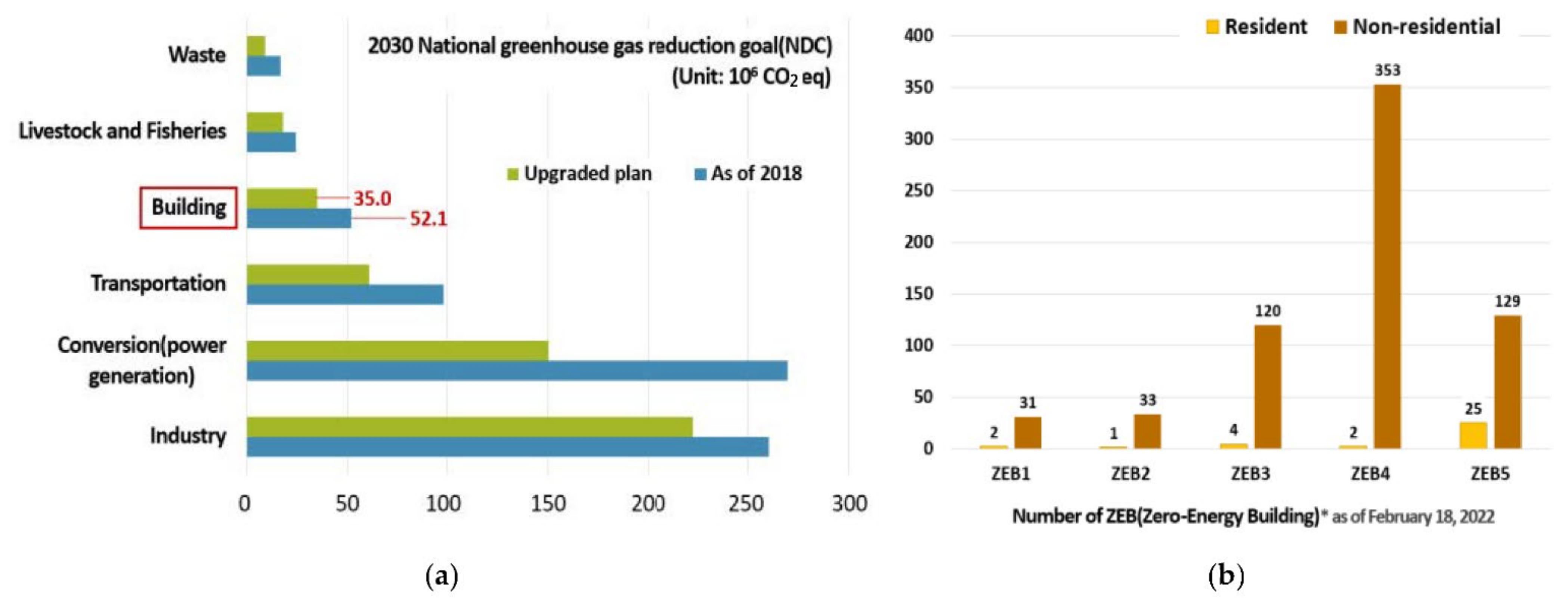


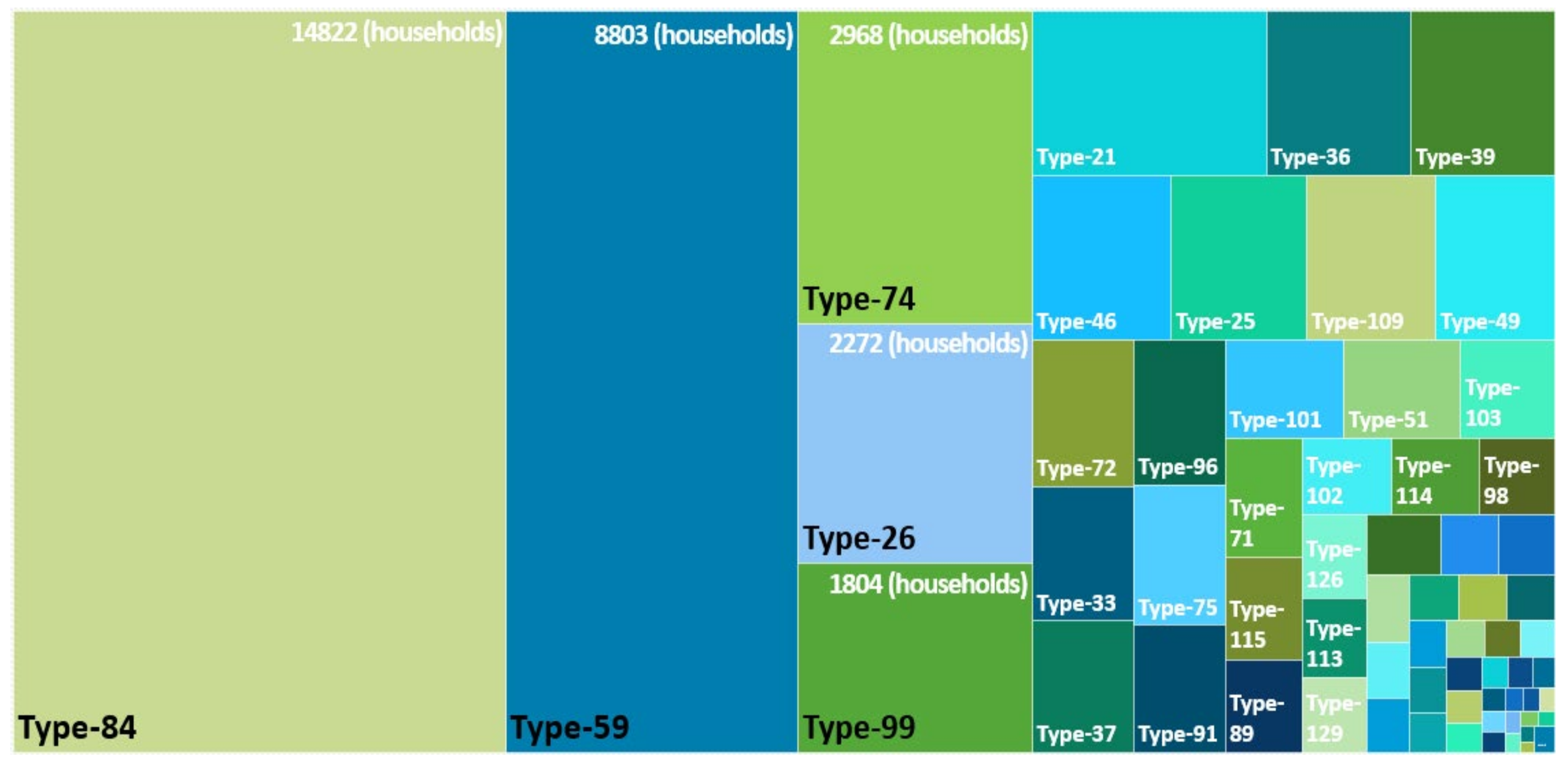
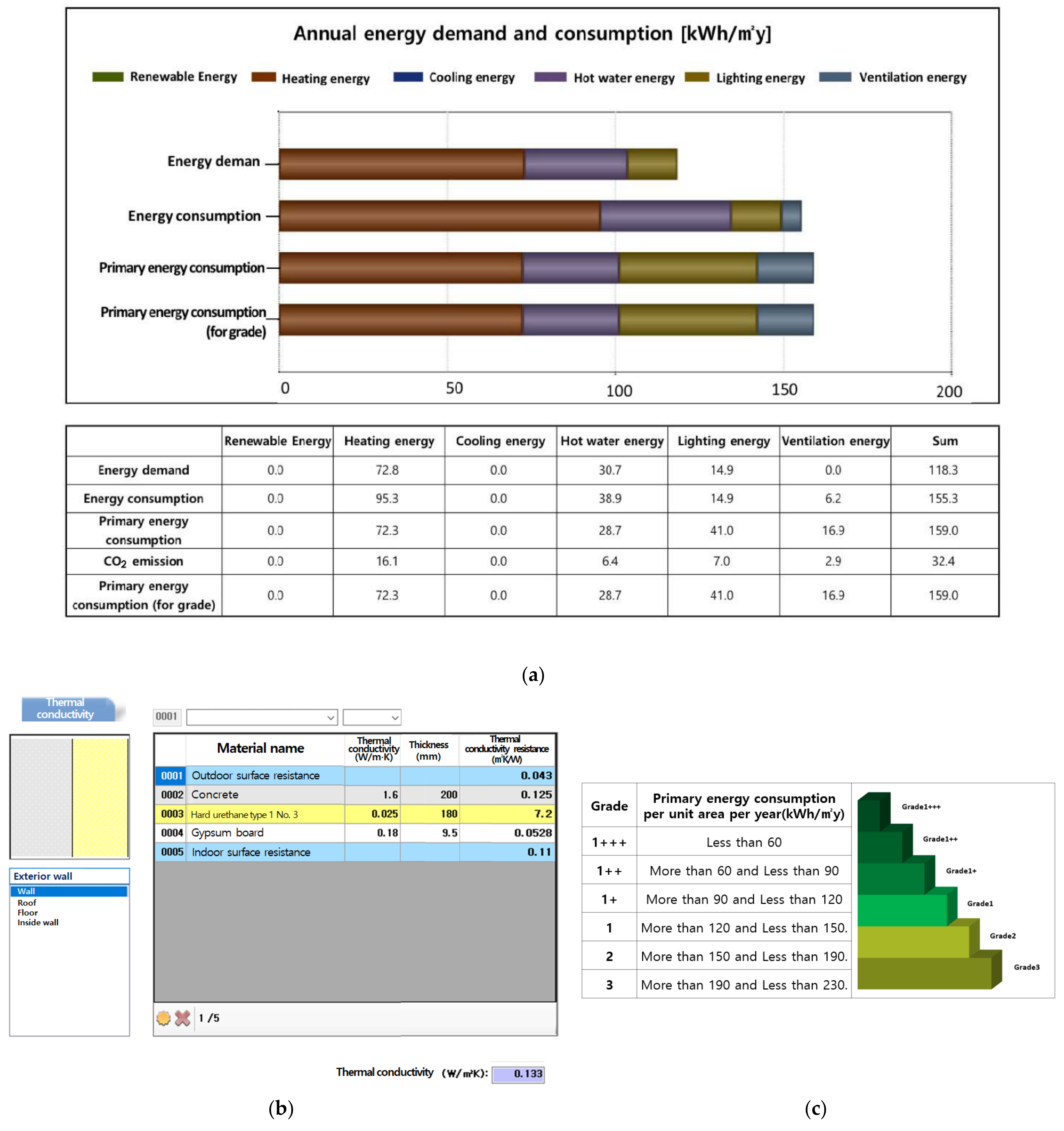


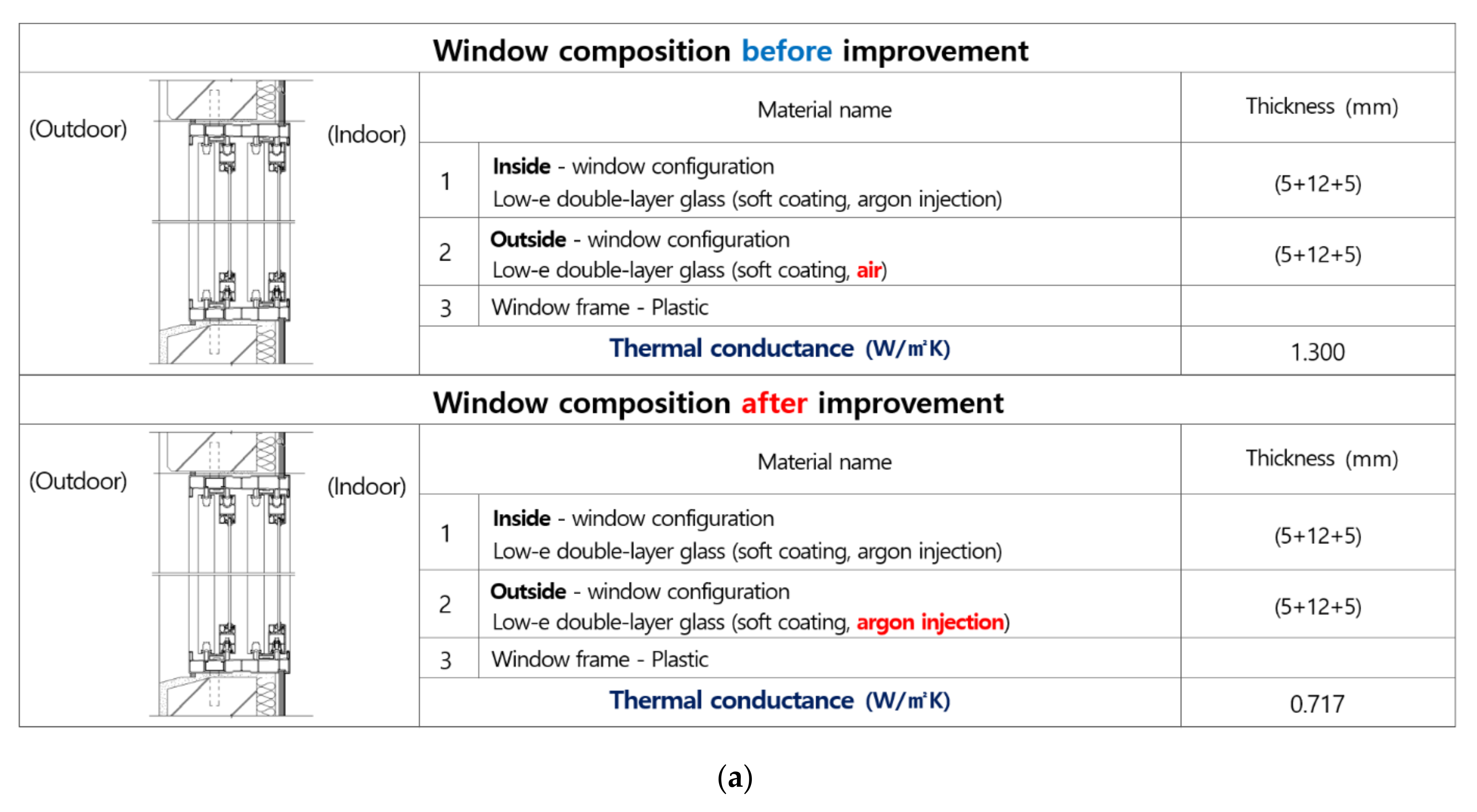

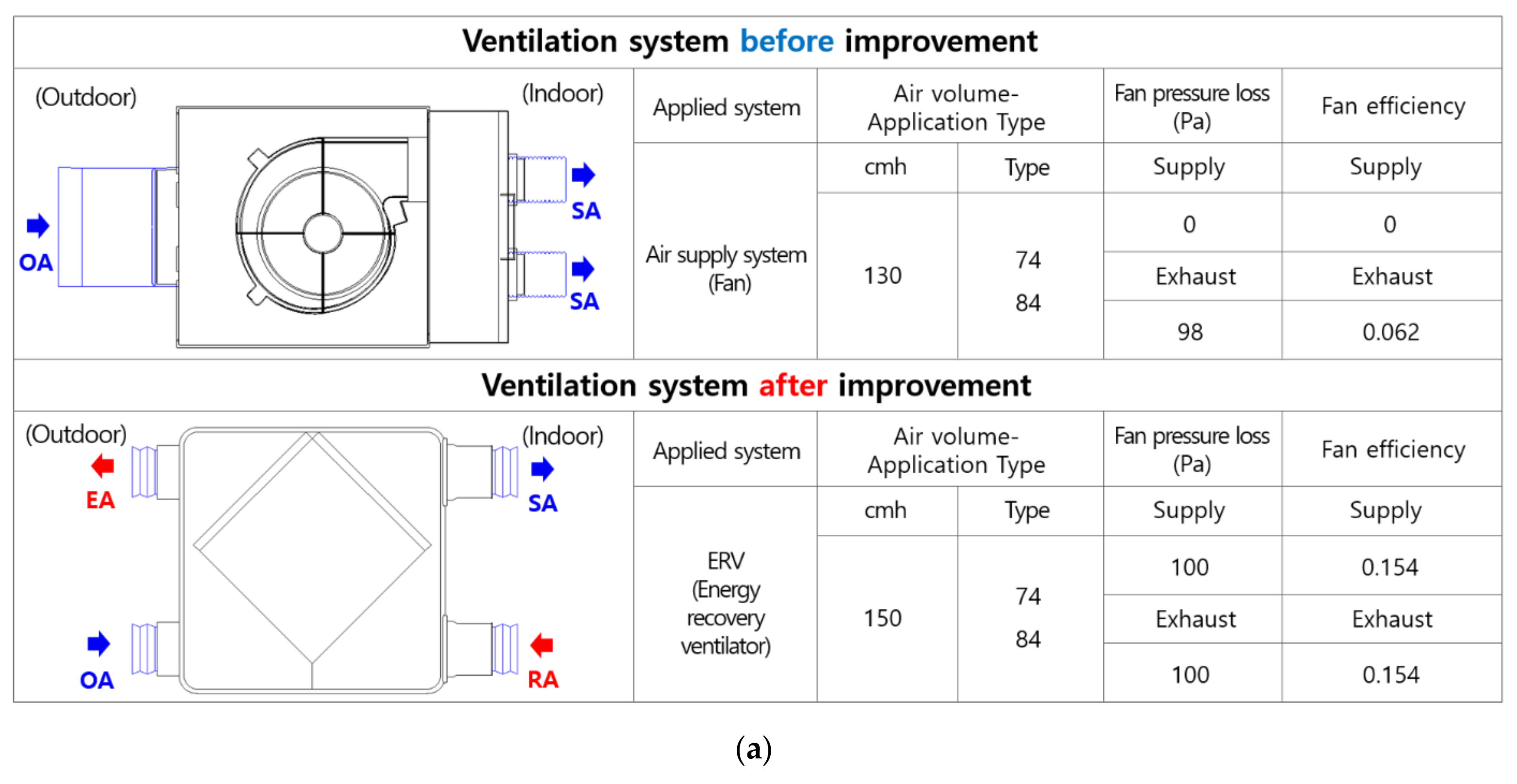
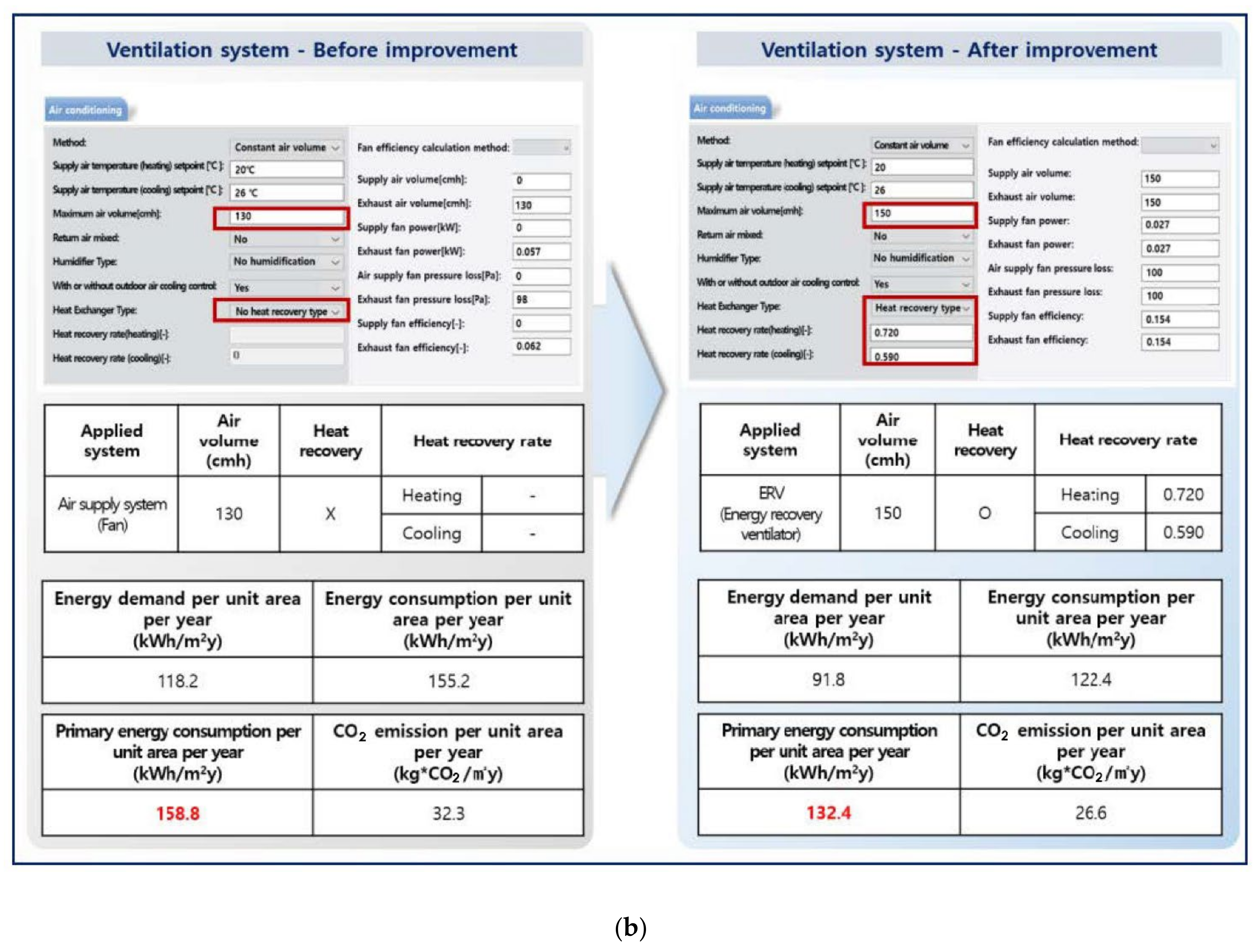

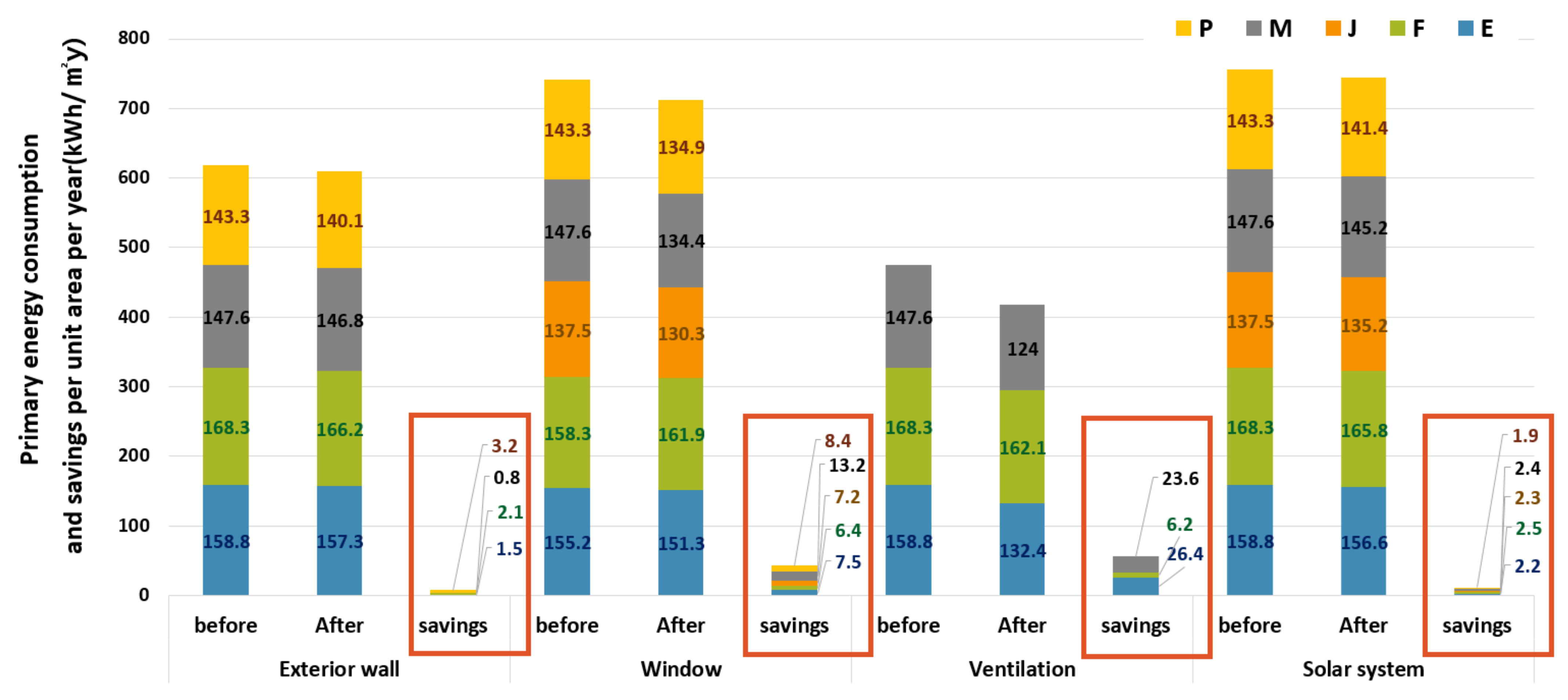
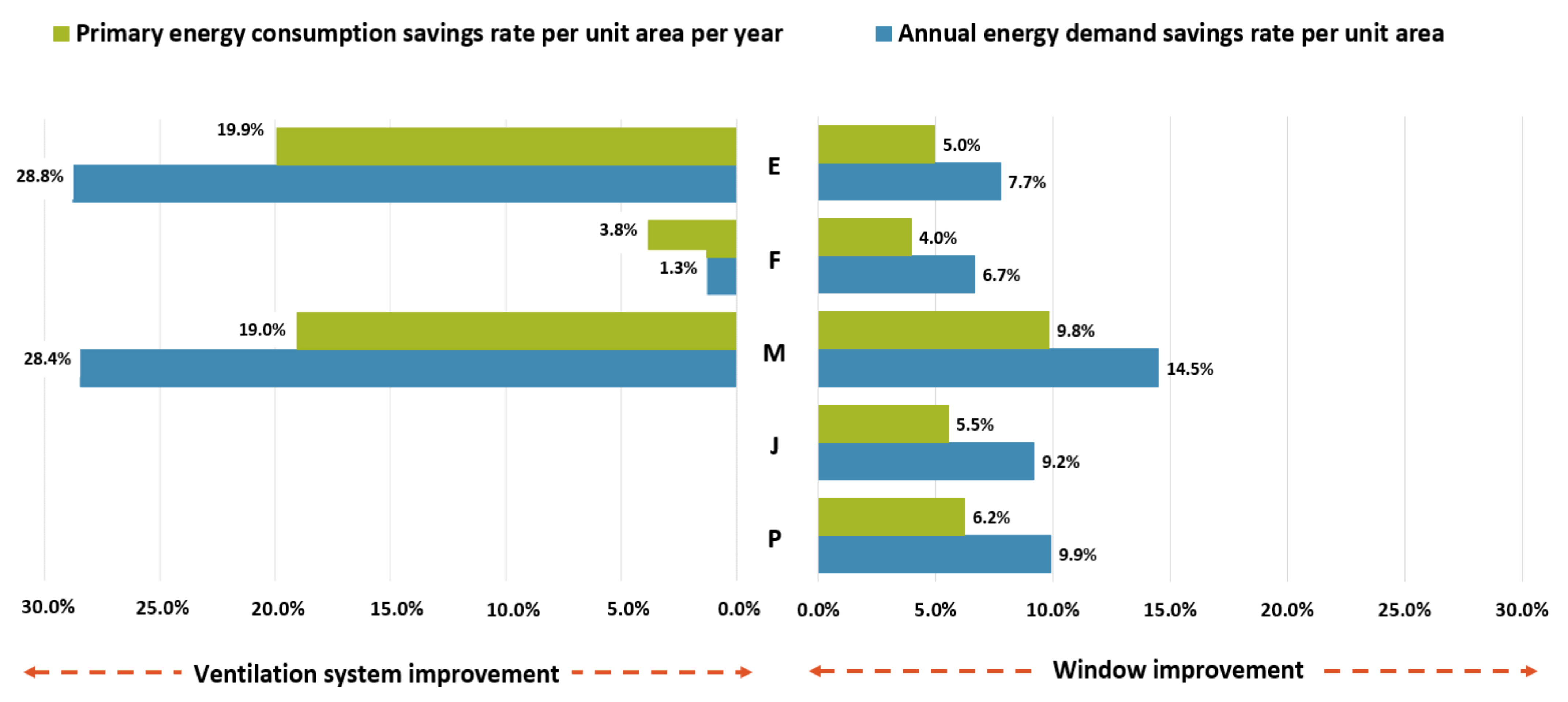

| Reference | Contents |
|---|---|
| [1,2] | Shortage of fossil fuel reserves and emergence of climate changes. |
| [3] | 2050 Carbon Neutral Scenario Plan. |
| [4] | 2030 Nationally Determined Contribution (NDC) Upgrade Plan. |
| Major topic | Energy technology to reduce CO2eq in buildings. |
| [5,12] | Reinforcement of energy efficiency ratings focused on new buildings and zero-energy building certification. |
| [15,16] | Approximately 59% of buildings are older than 20 years. |
| Major topic | Research into energy saving in existing buildings. |
| [20,21] | The energy consumption of MDUs accounts for the highest proportion [20,21]. |
| [22,23] | High proportion of energy consumption in the metropolitan area [22,23]. |
| Major topic | Improvement of energy consumption in apartment complexes in the metropolitan area. |
| This work | Selection of energy improvement factors and economic analysis of standard MDU complexes in Korea metropolitan region. |
| Insulation Material | Thermal Conductivity (W/m2K) | Number of Applied Complexes |
|---|---|---|
| Hard urethane type 1 No. 3 | 0.025 | 3 |
| Hard urethane type 2. No. 2. | 0.023 | 8 |
| Glass wool thermal insulation plate 24K | 0.037 | 2 |
| Bead method thermal insulation plate type 1 No. 2 | 0.035 | 1 |
| Bead method thermal insulation plate type 2 No. 1 | 0.031 | 2 |
| Bead method thermal insulation plate type 2 No. 2 | 0.032 | 21 |
| Bead method thermal insulation plate type 2 No. 3 | 0.033 | 5 |
| Bead method thermal insulation plate type 2 No. 4 | 0.034 | 2 |
| Extrusion method thermal insulation plate No. 1 | 0.024 | 1 |
| Extrusion method thermal insulation plate special | 0.027 | 1 |
| Heating Energy Demand per Unit Area (kWh/m2) | |||||||||||||
|---|---|---|---|---|---|---|---|---|---|---|---|---|---|
| Year | Jan | Feb | Mar | Apr | May | Jun | Jul | Aug | Sep | Oct | Nov | Dec | Avg. |
| 2014~2015 | 17.5 | 13.0 | 7.9 | 1.9 | 0.0 | 0.0 | 0.0 | 0.0 | 0.0 | 0.6 | 7.2 | 14.0 | 5.2 |
| 2021 | 12.9 | 8.3 | 5.5 | 0.8 | 0.0 | 0.0 | 0.0 | 0.0 | 0.0 | 0.3 | 4.2 | 9.5 | 3.5 |
| Savings | 4.6 | 4.7 | 2.4 | 1.1 | 0.0 | 0.0 | 0.0 | 0.0 | 0.0 | 0.3 | 2.9 | 4.5 | 1.7 |
| Improvement Status | MDU | Energy Demand per Unit Area per Year (kWh/m2 y) | Energy Consumption per Unit Area per Year (kWh/m2 y) | Primary Energy Consumption per Unit Area per Year (kWh/m2 y) |
|---|---|---|---|---|
| Before | E | 118.2 | 155.2 | 158.8 |
| F | 102.6 | 158.3 | 168.3 | |
| M | 119.3 | 150.8 | 147.6 | |
| P | 96.5 | 145.5 | 143.3 | |
| Average | 109.15 | 152.45 | 154.5 | |
| After | E | 116.5 | 153.2 | 157.3 |
| F | 100.5 | 155.4 | 166.2 | |
| M | 118.4 | 149.7 | 146.8 | |
| P | 93.2 | 141.1 | 140.1 | |
| Average | 107.2 | 149.9 | 152.6 |
| Improvement Status | MDU | Energy Demand per Unit Area per Year (kWh/m2 y) | Energy Consumption per Unit Area per Year (kWh/m2 y) | Primary Energy Consumption per Unit Area per Year (kWh/m2 y) |
|---|---|---|---|---|
| Before | E | 118.2 | 155.2 | 158.8 |
| F | 102.6 | 158.3 | 168.3 | |
| J | 92.7 | 121.9 | 137.5 | |
| M | 119.3 | 150.8 | 147.6 | |
| P | 96.5 | 145.5 | 143.3 | |
| Average | 105.9 | 146.3 | 151.1 | |
| After | E | 109.7 | 145.1 | 151.3 |
| F | 96.2 | 149.6 | 161.9 | |
| J | 84.9 | 112.3 | 130.3 | |
| M | 104.2 | 132.9 | 134.4 | |
| P | 87.8 | 134.1 | 134.9 | |
| Average | 96.6 | 134.8 | 142.6 |
| Improvement Status | MDU | Energy Demand per Unit Area per Year (kWh/m2 y) | Energy Consumption per Unit Area per Year (kWh/m2 y) | Primary Energy Consumption per Unit Area per Year (kWh/m2 y) |
|---|---|---|---|---|
| Before | E | 118.2 | 155.2 | 158.8 |
| F | 102.6 | 158.3 | 168.3 | |
| M | 119.3 | 150.8 | 147.6 | |
| Average | 113.4 | 154.8 | 158.2 | |
| After | E | 91.8 | 122.4 | 132.4 |
| F | 101.3 | 154.6 | 162.1 | |
| M | 92.9 | 119.3 | 124.0 | |
| Average | 95.3 | 132.1 | 139.5 |
| Improvement Status | MDU | Energy Demand per Unit Area per Year (kWh/m2 y) | Energy Consumption per Unit Area per Year (kWh/m2 y) | Primary Energy Consumption per Unit Area per Year (kWh/m2 y) |
|---|---|---|---|---|
| Before | E | 118.2 | 155.2 | 158.8 |
| F | 102.6 | 158.3 | 168.3 | |
| J | 92.7 | 121.9 | 137.5 | |
| M | 119.3 | 150.8 | 147.6 | |
| P | 96.5 | 145.5 | 143.3 | |
| Average | 105.9 | 146.3 | 151.1 | |
| After | E | 118.2 | 155.2 | 156.6 |
| F | 102.6 | 158.3 | 165.8 | |
| J | 92.7 | 121.9 | 135.2 | |
| M | 119.3 | 150.8 | 145.2 | |
| P | 96.5 | 145.5 | 141.4 | |
| Average | 105.9 | 146.3 | 148.8 |
| Improvement Status | MDU | Energy Demand per Unit Area per Year (kWh/m2 y) | Energy Consumption per Unit Area per Year (kWh/m2 y) | Primary Energy Consumption per Unit Area per Year (kWh/m2 y) |
|---|---|---|---|---|
| Before | E | 118.2 | 155.2 | 158.8 |
| F | 102.6 | 158.3 | 168.3 | |
| M | 119.3 | 150.8 | 147.6 | |
| Average | 113.4 | 154.8 | 158.2 | |
| After (Window and ventilation system) | E | 83.8 | 112.6 | 125.2 |
| F | 94.3 | 145.3 | 155.2 | |
| M | 78.9 | 102.3 | 111.4 | |
| Average | 85.7 | 120.1 | 131.6 |
| Improvement Status | MDU | Correction Factor for Heating | Primary Energy Consumption per Unit Area per Year (kWh/m2 y) | ||||
|---|---|---|---|---|---|---|---|
| Heating | Heating | Lighting | Ventilation | Sum | |||
| Before | E | 0.5 | 36.15 | 28.7 | 41.0 | 16.9 | 122.75 |
| F | 38.55 | 26.3 | 46.8 | 18.1 | 129.75 | ||
| M | 35.2 | 29.0 | 33.9 | 14.3 | 112.40 | ||
| After | E | 0.5 | 20.75 | 28.8 | 41.0 | 13.9 | 104.45 |
| F | 34.4 | 26.3 | 46.8 | 13.3 | 120.80 | ||
| M | 17.4 | 29.0 | 33.9 | 13.7 | 94.00 | ||
| Improvement Status | MDU | Primary Energy Consumption per Unit Area per Year (kWh/m2y) [Table 8] | After Correction | |
|---|---|---|---|---|
| Correction Factor | Primary Energy Consumption per Unit Area per Year (kWh/m2y) | |||
| Before | E | 122.75 | +4.22% | 127.93 |
| F | 129.75 | 135.22 | ||
| M | 112.40 | 117.14 | ||
| After | E | 104.45 | +4.22% | 108.86 |
| F | 120.80 | 125.90 | ||
| M | 94.00 | 97.97 | ||
| Complex | Improvement Status | Corrected Primary Energy Consumption per Unit Area per Year (kWh/m2y) | Type (m2) | District Heating Energy Cost ($/m2y) | Electricity Cost ($/m2y) | Sum ($/m2y) | ||
|---|---|---|---|---|---|---|---|---|
| District Heating Energy | Electricity | Sum | ||||||
| M | Before | 35.4 | 16.1 | 51.5 | 59 | 104 | 78.3 | 182.3 |
| 74 | 130.4 | 98.1 | 228.5 | |||||
| 84 | 148.0 | 111.2 | 259.2 | |||||
| After | 17.2 | 15.2 | 32.4 | 59 | 50.4 | 74.0 | 124.4 | |
| 74 | 63.2 | 92.6 | 155.9 | |||||
| 84 | 71.8 | 105.1 | 176.8 | |||||
| Improvement Factors | Type, Air Flow Rate | Product Price ($) | Installation Cost ($) | Total Cost ($) |
|---|---|---|---|---|
| Ventilation | 59 m2, 100 cmh | 500 | 2608 | 3108 |
| 74 m2, 150 cmh | 583 | 2781 | 3364 | |
| 84 m2, 150 cmh | 583 | 3090 | 3673 | |
| Window | 59 m2 | 5898 | 500 | 6398 |
| 74 m2 | 7115 | 583 | 7698 | |
| 84 m2 | 7068 | 667 | 7735 |
| Type | Annuity Present Value Factor | Annual Profit with Improvement ($) | Profit ($) (30 Years of Use) |
|---|---|---|---|
| 59 m2 | 23.914 | 57.9 | 1385 |
| 74 m2 | 72.6 | 1736 | |
| 84 m2 | 82.4 | 1970 |
| Type | Annuity Present Value Factor | Annual Profit with Improvement ($) | Profit ($) (30 Years of Use) |
|---|---|---|---|
| 59 m2 | 15.729 | 57.9 | 911 |
| 74 m2 | 72.6 | 1142 | |
| 84 m2 | 82.4 | 1296 |
Publisher’s Note: MDPI stays neutral with regard to jurisdictional claims in published maps and institutional affiliations. |
© 2022 by the authors. Licensee MDPI, Basel, Switzerland. This article is an open access article distributed under the terms and conditions of the Creative Commons Attribution (CC BY) license (https://creativecommons.org/licenses/by/4.0/).
Share and Cite
Lee, K.-W.; Kim, Y.I. Selection of Energy Improvement Factors and Economic Analysis of Standard MDU Complexes in Korean Metropolitan Regions. Energies 2022, 15, 4042. https://doi.org/10.3390/en15114042
Lee K-W, Kim YI. Selection of Energy Improvement Factors and Economic Analysis of Standard MDU Complexes in Korean Metropolitan Regions. Energies. 2022; 15(11):4042. https://doi.org/10.3390/en15114042
Chicago/Turabian StyleLee, Ki-Won, and Young Il Kim. 2022. "Selection of Energy Improvement Factors and Economic Analysis of Standard MDU Complexes in Korean Metropolitan Regions" Energies 15, no. 11: 4042. https://doi.org/10.3390/en15114042
APA StyleLee, K. -W., & Kim, Y. I. (2022). Selection of Energy Improvement Factors and Economic Analysis of Standard MDU Complexes in Korean Metropolitan Regions. Energies, 15(11), 4042. https://doi.org/10.3390/en15114042






